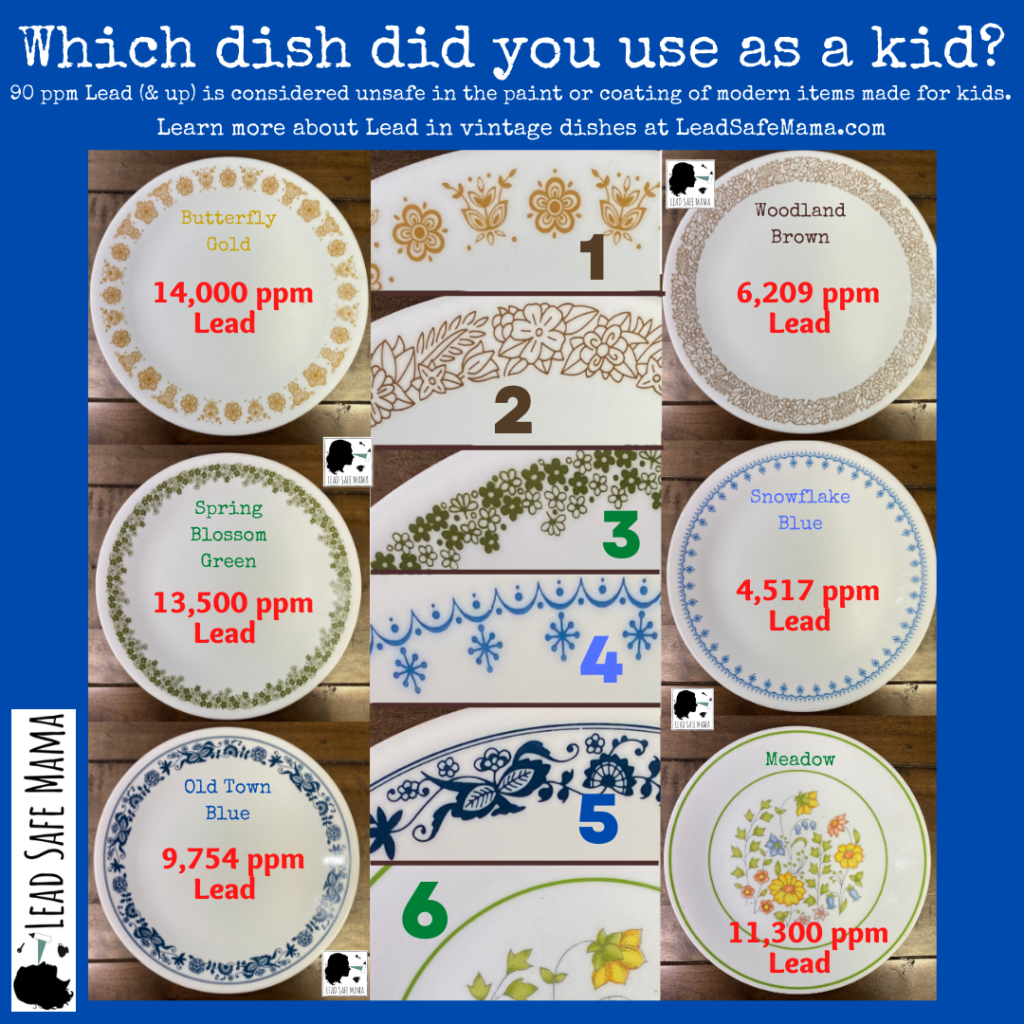We love our vintage Corelle dishes at the cottage. They are the same brand that I had growing up as a kid. They are lightweight, practically indestructible, and easy to clean. Whenever we are in a thrift store, we commonly snatch up an old piece or two that matches our pattern. As a result, we have a nice set that can sit up to twelve guests on those summer days when we have a walleye fish fry on the back porch.
Let’s Cover This Story…
Listen To This Story
What is Wrong With Our Corelle Vintage Dishes?
My wife was looking up something on cookware and ran across this nugget of information on the Internet. A website called Lead Safe Mama (LSM) was testing and presenting lead testing results of vintage cookware. We were floored at what the site was showing—picture after picture of vintage Corelle dishes and cookware we use in our cottage and home. The site indicated the dishes all have high lead levels in the decorative pattern. It turns out that Corning and others were using Lead in the pattern paint up until the mid-2000s. We never received notice that this was present…until now.
Latest Updates on Vintage Corelle Dishes
- Corelle Agrees To Start Testing Pre-2000 Vintage Dishes In Response To New Hampshire Lead Warning
- Outside Lab Vindicates Vintage Corelle Dishes – Determines Dishware Are Approved For Everyday Use
Should You Stop Using These Dishes?
While the independent consumer goods testing work of Lead Safe Mama, LLC is frequently challenged by vintage dishware fans (who are usually quite upset when they first learn that their dishes may not be safe for food use), it turns out that even Corelle recommends that you stop using vintage or older, (pre-2005) decorated Corelle pieces for functional food use purposes.

Lead Safe Mama reached out to Corelle® after they found high lead levels in the painted, colorful decorative elements of many Corelle® pieces. A representative from Corelle® confirmed that the company knew they used Lead in their pieces through the mid-2000s and told the site the company stopped using Lead in their decorative dishware patterns in about 2005.
Corelle Asks Owners to Use The Old Dishes and Cookware For Decoration
In an email exchange reported by a fan of LSM and Corelle®, the company issued the following response about Lead on their older products:
“Before the 1990s, virtually all glass and ceramic ware made anywhere in the world contained Lead as a primary ingredient in the decorating fluxes and glazes. All our products have been Lead-free since the mid-2000s. Lead content has never been regulated until recently. We recommend using the items you have as decorative pieces. We hope this information is helpful.”
It’s More Than Corelle Dishes That Have Lead Paint
Lead Safe Mama has been writing and alerting folks on this topic for over three years. LSM found that Corelle pieces have been high in Lead (and Cadmium) — since shortly after LSM started testing consumer goods for toxicants using XRF technology in 2019.
LSMs site has listed many dishes, bowls, casserole dishes, and Pyrex® measuring pieces that they have tested and reported on. There are too many to list out here. We likely have about 50 pieces between our cottage and home that may be headed to the attic.
Is it Safe to Use New Corelle Dishes?
According to LSM, Corelle® is a worldwide leader in producing lead-free dishware. They promote their basic white items as one of the most reliable Lead-free dishware solutions on the market today.
One of their designs, Bella Faenza, has the detail embossed into the glass (as a texture, not a painted design). These “embossed” Corelle dishes are all lead-free (as long as there are no colored elements.) Lead-free, simple white ones with no ornamental embellishments.
Why Is This Much Lead A Problem?
It just takes a tiny quantity of Lead to poison a child (or any human), and other than Lead Safe Mama, no one is presently examining the potential impact of eating from leaded vintage Corelle dishes.
But Snopes Says This is Unproven
In a six-year-old posting on Snopes.com, an alleged fact-checking site, they contend that the testing and warnings posted by Lead Safe Mama are “Scarelore.” In addition, the site alleges that the lead testing that LSM has paid a third-party accredited testing agency to do on these vintage dishes and cookware is “Unproven.” The Snopes article says the FDA indicated that “the ware is not necessarily unsafe because it is old, but it may not comply with current FDA standards.” They know how to confuse the story.
Consumer Reports Recommends You Should Test Your Vintage Or Imported Dishes For Lead ASAP
Late last year, Consumer Reports Magazine posted an article, Why You Should Test Your Vintage or Imported Dishes for Lead ASAP. The lead content and imported and antique dishes were the emphases of the story. According to Consumer Reports, while imported ceramics are the primary source of worry, consumers should also be aware of the possibility of lead exposure through thrift shop dishware or antique ceramics passed down from generation to generation.
New Hampshire Public Health Services Issues Warning
On May 20th, the New Hampshire Department of Health and Human Services posted a warning on their Facebook Page about older Corelle dishes.
“If you own Corelle® dinnerware from before 2005, consider removing it from your kitchen cabinets due to concerns for high levels of Lead. Corelle® recommends using their pre-2005 dishes as ‘decorative pieces.’
NH Public Health Services
Corelle indicated that it would begin a testing program for its older product lines in response to this warning.
“Given the recent demand for use of vintage products every day, we are further investigating pre-2000 Corelle products to confirm they comply with today’s safety standards – and whether it’s okay to use pre-2000 product as everyday dinnerware.“
Corelle – Instant Brands
Thumbwind will follow the development from the announced Corelle testing and let you know the outcome.
To See All the Vintage Corelle Dishes LSM Tested For Lead
Lead Safe Mama is doing excellent service. The site’s author has worked on this issue for years, and her efforts look to continue. Sadly, we will not be using these old dishes. I’m glad to know this food safety information that no one else seems to have covered.
For more information about the lead found in these and other vintage dishes, click here: Corelle® recommends using their pre-2005 dishes as “decorative pieces” due to concerns for high levels of Lead.
Vintage Dishes and Lead – FAQs
Which Corelle Dishes Have Lead?
Which Corelle Dishes Are Safe To Use?
Can Using Vintage Dishes In Microwave Ovens Cause Lead To Leach Into Food
Are Vintage Corelle Dishes the Only Ones With Problems?
What are some safe and creative ways to personalize dinnerware, particularly in light of concerns about lead in vintage Corelle dishes?
Follow Up Articles
- Corelle Agrees to Start Testing Vintage Dishes and Cookware in Response to New Hampshire Lead Warning
- 18 Articles Covering The Controversial Topic of Lead In Older Corelle Dishes
Related Foodie Reading on Thumbwind

7 Fantastic Michigan Food Companies Not To Overlook
14 Outstanding Breakfast Places Near Me To Check Out In Michigan’s Thumb
5 Reasons You Need To Upgrade Your BBQ To A Pellet Smoker
Ready, Set, Morel! Michigan Morels On Their Way – 5 Hunting Tips



